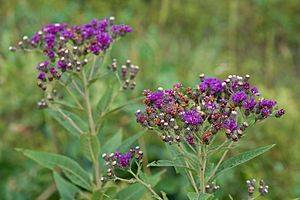Western ironweed facts for kids
Vernonia baldwinii, also known as the western ironweed or Baldwin's ironweed, is a tough plant that grows year after year. It's a type of herb found naturally in the central parts of North America.
Quick facts for kids Western ironweed |
|
|---|---|
 |
|
| Vernonia baldwinii inflorescence | |
| Scientific classification | |
| Genus: |
Vernonia
|
| Species: |
baldwinii
|
What Does Western Ironweed Look Like?
Vernonia baldwinii is a perennial herb, which means it lives for more than two years. It has special underground stems called rhizomes that help it spread.
Its main stems are covered in many tiny hairs, making them feel soft or fuzzy. These stems can grow up to about 1.2 meters (nearly 4 feet) tall. They also have branches.
The leaves grow directly from the stem and are arranged in an alternate pattern, meaning they don't grow directly opposite each other. Each leaf can be about 15 centimeters (6 inches) long and 4.5 centimeters (1.8 inches) wide.
The plant produces pretty purplish flowers. These flowers grow in round, flat clusters called inflorescences. Each flower cluster sits on a short, fuzzy stalk called a peduncle.
You can find western ironweed growing in dry soil. It likes open areas like prairies, pastures, and even some woods. It grows across a wide area, from Iowa to Missouri, Nebraska, Kansas, and Texas.
Where Does Its Name Come From?
The name of the plant's group, Vernonia, honors an English botanist named William Vernon. A botanist is a scientist who studies plants.
The second part of its scientific name, baldwinii, is a tribute to William Baldwin. He was an American botanist and doctor who first collected this plant.
The common name "western ironweed" tells us two things. "Western" refers to the part of the United States where this plant is often found. "Ironweed" comes from how strong and tough its stems and roots are. They are as strong as iron!
See also
 In Spanish: Vernonia baldwinii para niños
In Spanish: Vernonia baldwinii para niños

